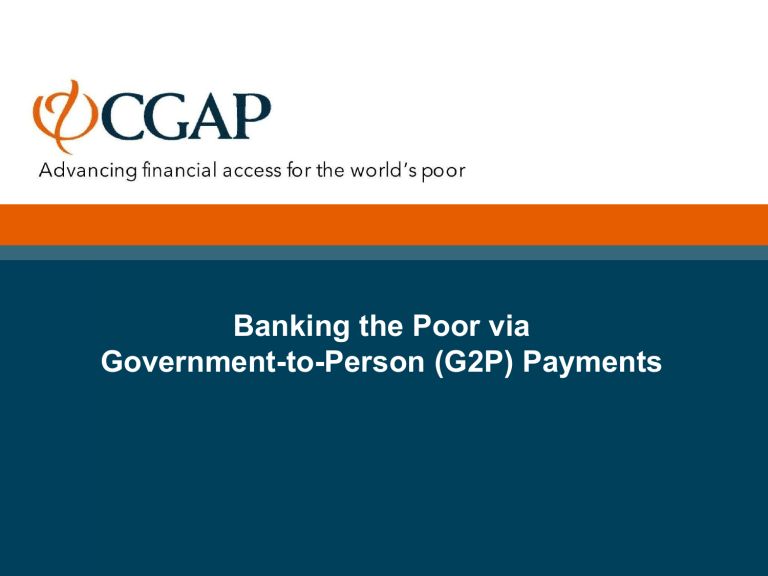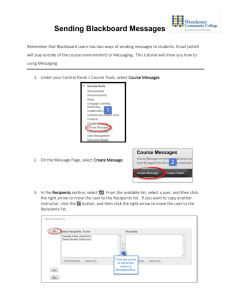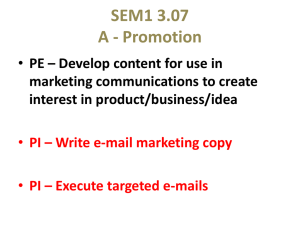Banking poor G2P recipients

Banking the Poor via
Government-to-Person (G2P) Payments
Government-to-person payments: Definition
G2P includes cash payments related to social programs as well as wages, pensions and other payments
Potential for financial inclusion
Globally, 170 million poor people receive a regular payment from their government
BUT
fewer than 20% receive their payment into an account at a regulated financial institution through which they can
Conveniently
Affordably
Safely …
save and make electronic transactions
The move from cash to electronic
Cutting cost and corruption
Argentina
• Ministry of Social Development switched from cash payments to a prepaid debit card number of participants who said they paid a bribe to access their benefits dropped
12-fold 1
Brazil
• In Brazil the switch to electronic delivery of Bolsa Familia grants resulted in a drop in proportional administrative costs between 2001 and 2006 from 14.7% of the grant value to
2.6% 2
1 Duryea and Schargrodsky (2007).
2 Consolidating several social benefits into one payment also accounts for a portion of the savings seen by Bolsa Familia. See Lindert et al.
(2007).
Banking poor G2P recipients: early experiences
South
Africa
• ¼ of the country’s 12.4 mil G2P recipients have their grant electronically transferred into accounts with either Allpay’s Sekulula card (a debit card-based bank account specifically designed for social transfer recipients) or
• Net1 (a payment services company which offers smartcard-based accounts).
1
India
• National Rural Employment Guarantee Scheme (NREGS) offers its 35 million recipients a choice of 4 ways to receive payment for days worked
• Choices include an electronic prepaid account accessed via smartcards issued by two technology firms, Fino and A Little World.
2
Brazil
• Caixa Economica is in the process of migrating 11.1 million Bolsa Familia recipients away from electronic benefit cards to saving accounts which include a Visa-branded debit card usable at more than 20,000 agents, other stores and ATMs.
• As of June 2009, the bank has converted 1.66 million recipients to this offering.
3
1 Net1 SEC filings (2009), SASSA (2008), BFA (2006).
2 Ministry of Rural Development (2009); Johnson (2008).
3 Pickens et al (forthcoming).
Growing cohort of G2P programs offer financially inclusive account to recipients
Brazil
Caixa Economica migrating
12.1 mil recipients to cardoperated bank account accessible via 20,000 agents
South Africa
¼ of 9 million people receive payment into accounts at
Absa (largest bank) and Net1
India
4 million NREGA recipients choose branchless banking over traditional delivery
But globally…
Fewer than 1 in 4 G2P recipients get payment into financially inclusive account
Will financial services boost social protection?
Financial inclusion can strengthen social protection for poor households
A growing body of evidence shows that access to financial services enables the poor to better withstand shocks, build assets, and link into the wider economy as fuller economic citizens.
1
“Asset effect” says that assets connect people to a more hopeful future, give cause for longterm planning, support entrepreneurial appetite, and raise owner’s standing in eyes of family and friends 2
When youth savings accounts were offered to AIDS-orphaned adolescents in
Uganda: 3
Improved expectations about the future
Increased plans for education (88% to 96%)
Improved their HIV prevention attitude scores (17.2 to 18.5)
1 See inter alia Dupas, Pascaline and Robinson (2008); Ssewamala, Alicea, Bannon and Ismayilova (2008); Littlefield, Morduch and Hashemi
(2003); Chen and Snodgrass (2001); Bynner and Paxton (2001); Sherraden (1991).
2
3
Sherraden, M. (1991). Assets and the poor: A new American welfare policy . Armonk, NY: M.E. Sharpe. See also Bynner & Paxton, 2001.
Ssewamala, Fred M., Stacey Alicea, William M. Bannon, Jr., and Leyla Ismayilova, “A Novel Economic Intervention to Reduce HIV Risks Among
SchoolGoing AIDS Orphans in Rural Uganda.” Journal of Adolescent Health 42 (2008) 102-104.
Will poor G2P recipients use financial services if offered?
Poor G2P recipients will use financial services…if good quality if offered
Brazil
• In 2004 when the cards were issued to Bolsa Familia recipients, 24% said using the card was “easy” or “very easy”
• One year later, the number increased to 96% 1
• Caixa Economica reports strong uptake of “simplified accounts” by 2 million recipients
Mexico
• Oportunidades recipients are offered a full savings account in Bansefi and over 1.5 million have elected to use it (among 5 million total recipients)
• These households saved an average of 12% of their government grant, with subsequent investments leading to a 35% increase in consumption after 5 years in the program 2
1 Polis Institute (2007).
2 Gertler, Martinez and Rubio-Codina (2006).
Is building financial services into G2P program expensive?
Financially inclusive options may be cheaper than traditional payment arrangements
Note: For a social transfer program which delivers a USD 40 grant monthly to 1 mil recipients, a card-based system with 10,000 agents equipped with card-reading point-of-sale (POS) terminals would be 10.8 percent cheaper after five years than a traditional set up paying grants over the counter in cash at a government office or branch of a state-owned bank
Can financial institutions offer services profitably?
The business case may be attractive for financial institutions
Figure: G2P Flows Suitable for Pairing with Basic Banking
Feature
Large number of recipients
Rationale
Scale needed to attract and retain interest of banks
Large payments, relative to recipient income Greater potential for sizeable float revenue
Frequent schedule of payments, not scheduled to end in short term
Recurring stream of payments generates dependable fee income for banks
Promise of future payments encourages recipients to utilize and become familiar with operating the account.
Conclusion
Conditions need to be enabling:
1.
Appropriate nature of G2P flows to make business case for banks
2.
3.
4.
Regulatory openness to enable branchless approaches
Presence of entity with standing and appetite to spark the change, such as Ministry of Social Development in Brazil
Donors can help design experiments which include measurement of usage of financial services, impact on welfare, and understanding business case for providers
Advancing financial access for the world’s poor www.cgap.org
www.microfinancegateway.org




